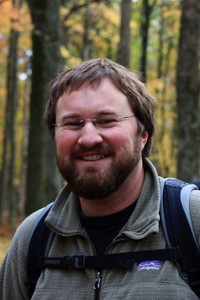
Plant Remains are Great Biomarkers for Clues on Ancient Climate Change
Students in Aaron Diefendorf and Krista Smileks Geology through Film spring quarter class have been learning about real science as seen through a Hollywood lens.
Weve watched some quality Hollywood movies, like Day After Tomorrowwhich has terrible science, says Diefendorf. The cartoon Ice Age, on the other hand, is pretty accurate.
The classbuilt for non-science majorsis fun to teach, Diefendorf says. But it also weighs heavy with importance.
Its critical to teach science to non-science majors because it interacts with their lives all the time. Its important that if this is going to be the only science class they take, that we teach them the concepts that touch on their lives, like climate change, natural disasters and human impacts on the world, he says.
Considering Diefendorfs research interests in climate change, his urgency for science outreach and education are understandable. While earning a PhD in geology and biogeochemistry from Penn State, Diefendorf spent much of his time studying carbon isotope values of fossil plant remains from millions of years ago to better understand rising levels of carbon dioxide that caused rapid climate change.
In a study published in Proceedings of the National Academy of Sciences, Diefendorf and colleagues at Penn State found that environmental conditions and plant types have important controls on the ratio of carbon isotopes in modern leaves and by using this information, you can better constrain ancient changes in the carbon cycle.

Diefendorf studies fossilized plants all over the U.S.
By looking at fossilized organic matter, we can actually use different molecules on different scales to reconstruct what plants were there in the past and how climate influences different types of plants, Diefendorf says. They may be from 150 million years ago, but it has some pretty powerful applications for today.
He arrived at the University of Cincinnati in January as an assistant professor in the
, but his research is only partly focused on the major Earth systems. Leaning heavily on chemistry and biology, Diefendorf hopes to create a research group in the
McMicken College of Arts and Sciences
that focuses on reconstructing past climates through biogeochemistry. He is also collaborating with other A&S faculty to obtain an isotope ratio mass spectrometer which will help Diefendorf and others study carbon isotopes.
Even though hes been at UC a short time, he is busy teaching, applying for grants, and preparing for field work this summer in Tennessee, Florida and South Carolina.
Right now Im getting my lab going and finding graduate students, Diefendorf says. Were already building the analytic capabilities of the geology department, which is a lot of fun. The department has been really supportive and its great to be in a place that has a huge commitment to doing great research.
Related Stories
How to keep birds from flying into your windows
July 3, 2024
UC College of Arts and Sciences professor Ron Canterbury tells the Indianapolis Star that simple steps can prevent birds from strike windows around your home or business. Yahoo! News shares the story.
Meet UC’s Miss Ohio
July 1, 2024
UC biomedical science student Stephanie Finoti credits UC for helping to prepare her for the Miss Ohio Scholarship Pageant. She will represent Ohio in the national competition in January.
UC alum credits journalism program with early success
June 26, 2024
Zachary Jarrell came to the University of Cincinnati in 2019 to pursue a degree in statistics. In 2023, he graduated with a Bachelor’s in Journalism. For many undergraduates, the journey through college rarely takes the expected track. Detours happen, and majors change. When plans switch up, it can be helpful to a student’s success to find support. For Jarrell, it was the people he worked alongside in the journalism department who helped him on his journey. It has left a lasting impression on his life so far, guiding him to multiple internships as an undergraduate, real-world experience in prominent news outlets, and eventually a successful career in the highly competitive field of journalism.
